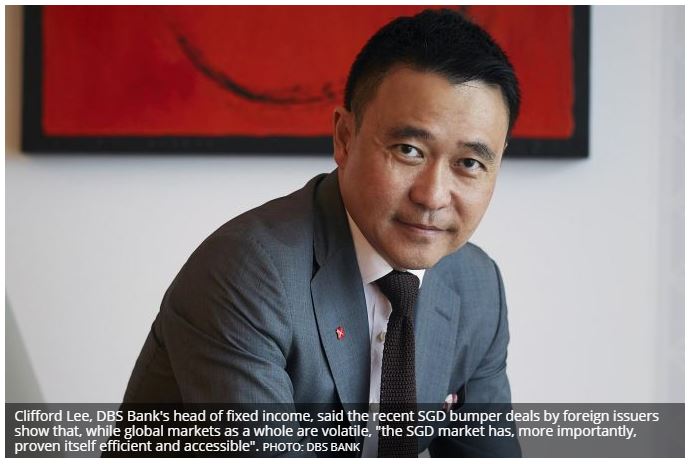More foreign issuers target Singapore-dollar market amid volatility
BANKERS here are hopeful that more foreign issuers will be making a beeline for the local debt market, in light of some major deals recently.
They say that foreign issuers are finding the Singapore dollar (SGD) market efficient and stable, relative to the bigger – but more volatile – US/Euro dollar markets.
Clifford Lee, DBS Bank’s head of fixed income, said the recent SGD bumper deals by foreign issuers show that, while global markets as a whole are volatile, “the SGD market has, more importantly, proven itself efficient and accessible”.
This wasn’t the case early this year when the USD and Euro markets were very cost competitive, he said. However, the cost advantage became less obvious as the year wore on, he added.
In the year to date, there have been 27 deals by foreign issuers worth S$3.4 billion, accounting for 15.7 per cent of total volume. Last year, foreign issuers sold 34 bonds worth S$7.3 billion, or 29.5 per cent of total volume.
Last week, Swiss banking giant UBS sold S$700 million Tier 1 perpetuals at an interest rate of 5.875 per cent, attracting orders of more than S$1.6 billion. Two weeks before that, Hong Kong’s Shangri-La Hotel issued an S$825 million, seven-year bond at 4.5 per cent.
Both UBS and Shangri-La were making their SGD debuts, seizing on the strong SGD liquidity amid overall volatility.
The UBS deal was the largest SGD Tier 1 issuance by a foreign bank (with the exception of HSBC, which some may consider a local name in Singapore), said Rajan Bagri, Standard Chartered Bank’s head of financial institutions group, debt capital markets for Europe and the Americas.
HSBC had sold a S$750 million perpetual in September at 5 per cent.
UBS’ final size of S$700 million surpassed the S$500 million target, allowing the pricing to come in 12.5 basis points tighter than the 6 per cent initial guidance, said Mr Bagri.
The deal was done against the UK Brexit backdrop, which is making the US and Euro markets volatile, he said.
“SGD is one of very few Asian markets which can provide issuers with access to an alternative (that is, non USD) capital pool for Tier 1 and Tier 2. It offers a genuine alternative for high-grade western financial institutions,” said Mr Bagri.
Foreign issuers come to Asia for two purposes – to diversify their investor base and to achieve cost savings on an after-swap basis to their base currency, said DBS’ Mr Lee.
It is estimated that the savings to UBS from its maiden SGD deal was about 50 basis points per annum.
In comparative terms, the final pricing (5.875 per cent coupon) was very competitive, versus where UBS might have raised USD Tier 1 at the time, said Mr Bagri.
“Alongside the cost benefit, this transaction offered UBS worthwhile investor diversification and an opportunity to raise a more bespoke amount of Tier 1 capital without relying on the more volatile USD/Euro markets,” he said. He noted that the SGD bond market liquidity has been particularly strong this year, driven by sizeable redemptions and reduced supply.
SGD bond redemptions this year stand at about S$22.8 billion, compared with S$20.8 billion of public issuances year to date.
Mr Bagri is looking forward to more foreign issuers for the SGD market.
“Many UK and European clients of Standard Chartered Bank continually monitor the SGD market as a potential source of Tier 2 or Tier 1 capital.
The SGD bond market offers the advantage of meaningful size, clear diversification versus USD/Euro markets and an investor base familiar with European bank capital instruments,” he said.
Said Mr Lee: “UBS joins the ranks of many other leading global banks which have tapped the SGD bond market, proving it to be deep and efficient enough to be able to support benchmark bond issuances.
“We do expect to bring more of such deals from foreign issuers to the market whenever it turns favourable.”
Source: https://www.businesstimes.com.sg/banking-finance/more-foreign-issuers-target-singapore-dollar-market-amid-volatility


 Thailand
Thailand




